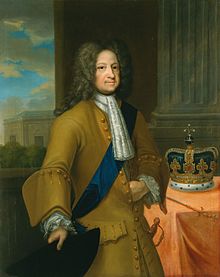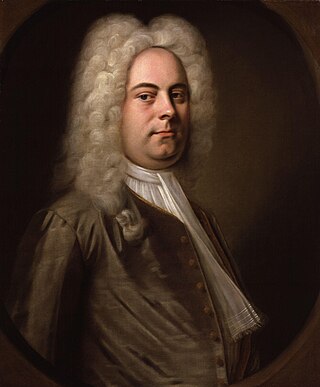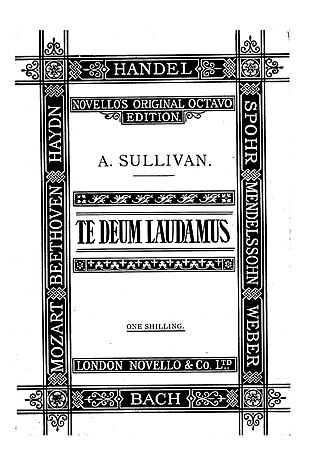
The Te Deum in D major, "Queen Caroline" (HWV 280) is a canticle Te Deum in D major composed by George Frideric Handel in 1714.

The Te Deum in D major, "Queen Caroline" (HWV 280) is a canticle Te Deum in D major composed by George Frideric Handel in 1714.
When Queen Anne died in 1714, her second cousin the Elector of Hanover became King of Great Britain as George I. His daughter-in-law Caroline of Ansbach thus became Princess of Wales. Caroline left Hanover and traveled to Britain, making the only sea voyage she ever took in her life, and arrived at Margate in September 1714. Her safe arrival was celebrated by the composition of this Te Deum by Handel, who had been resident in London since 1712 and had composed a number of pieces for royal occasions. [1] The Te Deum was performed in the Chapel Royal of St. James's Palace in that same month, on the 26th, and again on 17 October. [2] Since Caroline later became Queen as consort of George II, the Te Deum composed to give thanks for her safe arrival in Britain became known as the "Queen Caroline" Te Deum. George I attended the performance of the Te Deum and subsequently doubled Handel's "pension", or salary, he had been granted by Queen Anne of two hundred pounds a year for life to four hundred. [3]


The work calls for six solo vocalists, chorus and instrumental ensemble including trumpet.
(Soloists, Chorus and Orchestra)
(Tenor solo with orchestra, followed by chorus with orchestra, then bass soloist with orchestra)
(Alto solo with solo recorder and orchestra, joined by chorus)
(Soloists, chorus, solo trumpet and orchestra)
(Alto solo with orchestra)
(Chorus with solo trumpet and orchestra)
Handel, a recent emigrant to Britain from Germany, studied the works of Henry Purcell in learning how to set English words to music. The section beginning "Vouchsafe, O Lord", shows a particular influence of Purcell, but the piece also includes the operatic style Handel used in the theatre, for instance in the alto aria with recorder, "When thou tookest upon thee." [2]
Te Deum in D major, HWV 280 : Scores at the International Music Score Library Project

Ode for the Birthday of Queen Anne is a secular cantata composed by George Frideric Handel to a libretto by Ambrose Philips, of which the first line, "Eternal source of light divine", provides an alternative title for the work. It was probably composed during January 1713 for a performance on 6 February 1713, although there is no record of the performance having actually taken place. Other catalogues of Handel's music have referred to the work as HG xlvi A; and HHA i/6.
A coronation anthem is a piece of choral music written to accompany the coronation of a monarch.

Hodie is a cantata by Ralph Vaughan Williams. Composed between 1953 and 1954, it is the composer's last major choral-orchestral composition, and was premiered under his baton at Worcester Cathedral, as part of the Three Choirs Festival, on 8 September 1954. The piece is dedicated to Herbert Howells. The cantata, in 16 movements, is scored for chorus, boys' choir, organ and orchestra, and features tenor, baritone, and soprano soloists.

Joshua is an oratorio by George Frideric Handel. It was composed in a month, from 19 July 1747 to 19 August 1747, six months before the beginning of the oratorio season. Joshua is Handel's fourth oratorio based on a libretto by Thomas Morell. The oratorio premiered on 9 March 1748 at the Covent Garden Theatre, London. Joshua is based on the Biblical story of Joshua as the leader of the ancient Israelites. The story follows the Israelites from their passage over the Jordan River into Caanan and through the Battle of Jericho. The work also includes a love story elaborated from a few hints in the Biblical narrative between Caleb's daughter Achsah and Othniel, a young soldier.

An Occasional Oratorio is an oratorio by George Frideric Handel, based upon a libretto by Newburgh Hamilton after the poetry of John Milton and Edmund Spenser. The work was written in the midst of the Jacobite rising of 1745–1746, the attempt to overthrow Handel's patrons the Hanoverian monarchy under George II and replace them with a Stuart restoration under Charles Edward Stuart, "Bonnie Prince Charlie". The Occasional Oratorio is unique among Handel's works which he labelled "oratorio" in that it does not tell a story or contain elements of a drama, but was intended as a defiant and patriotic rallying piece.

Alexander Balus is an oratorio by George Frideric Handel, named after its title character, the Seleucid king Alexander Balas. The work has three acts and was written in English. The period of the story is from 150 B.C to 145 B.C. The libretto is by Thomas Morell after the biblical book of 1 Maccabees.
Psalm 90 is a musical composition by the American composer and insurance executive Charles Ives, written in 1923–24.

The Festival Te Deum is the popular name for an 1872 composition by Arthur Sullivan, written to celebrate the recovery of Albert Edward, Prince of Wales from typhoid fever. The prince's father, Prince Albert, had died of typhoid fever in 1861, and so the prince's recovery was especial cause for celebration.

Arthur Sullivan's Te Deum Laudamus—A Thanksgiving for Victory, usually known as the Boer War Te Deum, is a choral work composed by Sullivan in the last few months of his life. It was commissioned on behalf of Dean and Chapter of London's St. Paul's Cathedral by the cathedral's organist, Sir George Martin, as part of a grand service to celebrate the expected British victory in the Boer War.

The Light of the World is an oratorio composed in 1873 by Arthur Sullivan. Sullivan wrote the libretto with the assistance of George Grove, based on the New Testament. The work was inspired by William Holman Hunt's popular 1853–54 painting, The Light of the World. The story of the oratorio follows the whole life of Christ, told mostly in the first person, focusing on his deeds on Earth as preacher, healer and prophet.
Coronation Ode, Op. 44 is a work composed by Edward Elgar for soprano, alto, tenor and bass soloists, chorus and orchestra, with words by A. C. Benson.

The Te Deum for the Victory at the Battle of Dettingen in D major, HWV 283, is the fifth and last setting by George Frideric Handel of the 4th-century Ambrosian hymn, Te Deum, or We Praise Thee, O God. He wrote it in 1743, only a month after the battle itself, during which Britain and its allies Hannover and Austria soundly routed the French.
As pants the hart is an anthem composed by George Frideric Handel for the Chapel Royal of Queen Anne and subsequently revised. There are five versions of the work, the first being completed in 1713, and the final in 1738. HWV 251a was the first anthem Handel composed for the Chapel Royal.

Utrecht Te Deum and Jubilate is the common name for a sacred choral composition in two parts, written by George Frideric Handel to celebrate the Treaty of Utrecht, which established the Peace of Utrecht in 1713, ending the War of the Spanish Succession. He composed a Te Deum, HWV 278, and a Jubilate Deo, HWV 279. The combination of the two texts in English follows earlier models. The official premiere of the work was on 13 July 1713 in a service in St Paul's Cathedral in London.

Messiah, the English-language oratorio composed by George Frideric Handel in 1741, is structured in three parts. The wordbook was supplied by Charles Jennens. This article covers Part I and describes the relation of the musical setting to the text. Part I begins with the prophecy of the Messiah and his virgin birth by several prophets, namely Isaiah. His birth is still rendered in words by Isaiah, followed by the annunciation to the shepherds as the only scene from a Gospel in the oratorio, and reflections on the Messiah's deeds. Part II covers the Passion, death, resurrection, ascension, and the later spreading of the Gospel. Part III concentrates on Paul's teaching of the resurrection of the dead and Christ's glorification in heaven.

Messiah, the English-language oratorio composed by George Frideric Handel in 1741, is structured in three parts. This listing covers Part II in a table and comments on individual movements, reflecting the relation of the musical setting to the text. Part I begins with the prophecy of the Messiah and his birth, shows the annunciation to the shepherds and reflects the Messiah's deeds on earth. Part II covers the Passion in nine movements including the oratorio's longest movement, an air for alto He was despised, then mentions death, resurrection, ascension, and reflects the spreading of the Gospel and its rejection. The part is concluded by a scene called "God's Triumph" that culminates in the Hallelujah chorus. Part III of the oratorio concentrates on Paul's teaching of the resurrection of the dead and Christ's glorification in heaven.

Messiah, the English-language oratorio composed by George Frideric Handel in 1741, is structured in three parts. This listing covers Part III in a table and comments on individual movements, reflecting the relation of the musical setting to the text. Part I begins with the prophecy of the Messiah and his birth, shows the annunciation to the shepherds as a scene from the Gospel of Luke, and reflects the Messiah's deeds on Earth. Part II covers the Passion, death, resurrection, ascension, and the later spreading of the Gospel. Part III concentrates on Paul's teaching of the resurrection of the dead and Christ's glorification in heaven.

Sing Unto God, is an anthem composed by George Frideric Handel. It was performed for the royal wedding on 27 April 1736 at the Chapel Royal in St James's Palace, London with Francesca Cuzzoni-Sandoni, Carlo Broschi "Farinelli", and Francesco Bernardi "Senesino". The text was adapted from verses of Psalms 68, 106 and 128.

Chandos Jubilate, HWV246, is a common name for a choral composition by George Frideric Handel. It was published as the first of the Chandos Anthems, and is known also as Chandos Anthem No. 1 and as Jubilate in D Major. A setting of Psalm 100, "O, be joyful in the Lord", it is the first in a series of church anthems that Handel composed between 1717 and 1718, when he was composer in residence to James Brydges, later 1st Duke of Chandos. The anthem was probably first performed at St. Lawrence's church, Whitchurch, near Brydges' country house. The work is written for a small ensemble of instrumentalists, solo singers and choir, and is approximately twenty minutes in length.

The Te Deum in C is a sacred choral composition by Benjamin Britten, a setting of the Te Deum on the English text from the Book of Common Prayer. Britten wrote it between 11 July and 17 September 1934. It is scored for a treble solo, four-part choir (SATB) and organ.